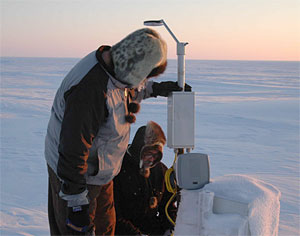Wildlife Challenges Lead to Wireless Solutions
Published: 29 February 2008
As reported in late 2006, a total precipitation sensor (TPS) was installed near the ARM North Slope of Alaska (NSA) site in Barrow, to provide measurements of boundary layer (surface to 1000-m altitude) environmental conditions. After falling victim to curious and possibly hungry lemmings and other wildlife in the area, the fiber optic cable used to transfer data from the sensor to the Great White instrument shelter was recently replaced with a wireless data acquisition system and virtual access port. This not only negates the possibility of further cable damage from our furry friends, but reduces the potential for water-related damage during peak melting season and allows remote access for monitoring the data.

Though covered by snow during the winter, exposure of the 1-km length of fiber optic cable during the summer months clearly presented a temptation to the local animal population. “Lemmings apparently don’t respect the fact that this is mil-spec armored cable,” said Mark Ivey, ARM Site Manager for the NSA locale. Enclosing the cable within buried conduit was considered, but operations and engineering staff proposed another solution: a point-to-multipoint weblink to enhance the existing wireless system for the Great White towercam. Because the towercam and the TPS are in nearly opposite directions from the Great White, the devices required reprogramming of the wireless bridge at the Great White for relocation near the TPS, and the purchase of a more sophisticated wireless bridge to support an omni-directional antenna. Not only was this solution more cost effective and less disruptive to the environment than the buried conduit option, it allows for easier relocation or addition of other sensors.
An Ethernet control device now provides a virtual port from which the software acquires data from the TPS. Operations staff are updating the sensor’s installation manual to reflect the recent upgrades, and data ingest using the new wireless data acquisition system has begun. A short run of metal conduit to protect exposed wires at the sensor is planned for spring, when temperatures warm up enough to keep the cables flexible during handling.
The ARM Climate Research Facility is a DOE Office of Science user facility. The ARM Facility is operated by nine DOE national laboratories, including .
Keep up with the Atmospheric Observer
Updates on ARM news, events, and opportunities delivered to your inbox
ARM User Profile
ARM welcomes users from all institutions and nations. A free ARM user account is needed to access ARM data.


















